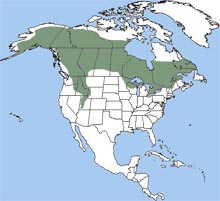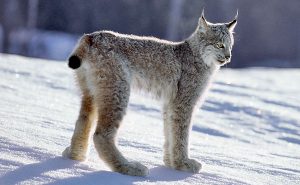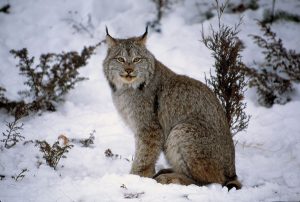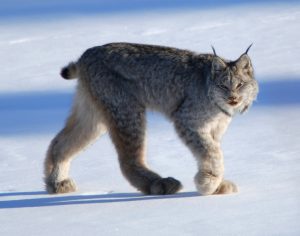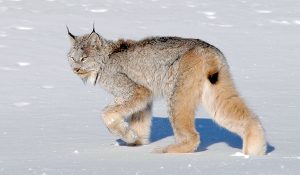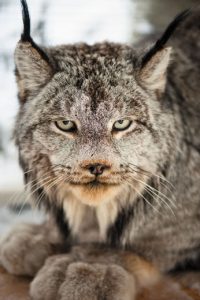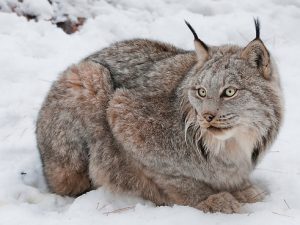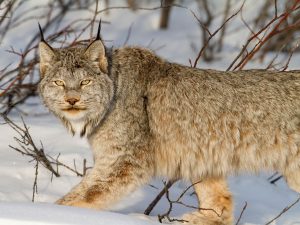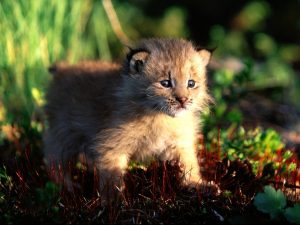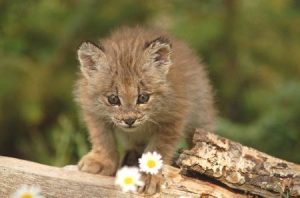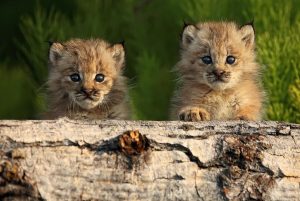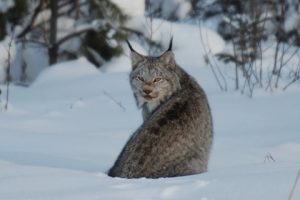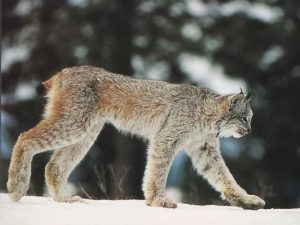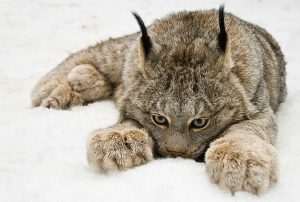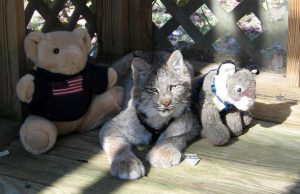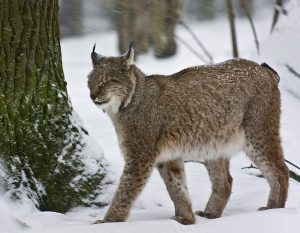Canada Lynx (Canadian Lynx): Elusive Predator with Critical Habitat and Competitive Advantage
In the snowy landscapes of the North, the Canada Lynx blends effortlessly into its surroundings. Imagine walking through the snow-covered forests of the North, where the silence is only broken by the faint rustle of leaves. Suddenly, a shadow moves. It’s the Canadian Lynx, gliding through the snow with the grace of a ghost, its tufted ears and keen eyes scanning the landscape. For centuries, this elusive predator has been a symbol of the wilderness, both mysterious and powerful, relying on its stealth and sharp hunting instincts to thrive in harsh, frozen landscapes.
The Mysterious Canada Lynx
The Canada Lynx is a master of camouflage, blending seamlessly into the snowy forests of North America. These cats, with their tufted ears, long legs, and large paws, are specifically adapted to their cold, northern habitats. They are most often found in the dense fir forests of Canada, Montana, and Washington. What makes the Canadian Lynx truly captivating is its elusive nature—its ability to move undetected, even in vast, open landscapes. Some say the lynx’s silence is its most powerful weapon. A well-known story from Washington recounts a hiker who stumbled upon a lynx sitting motionless just feet away, so perfectly camouflaged against the snow-covered ground that it took several moments before the hiker realized it was there.
Canada lynx, also called the Canadian lynx, is a mid-sized cat species ranging across northern parts of the United States, as well as Canada, and Alaska. With a well-developed body and long legs, its hind limbs being a touch longer than the forelimbs, the Canada lynx has a somewhat arched appearance. Similar to other lynx species, these predatory cats have long, dense fur, ruffed face, triangular ears tipped with tufts of hair, and a short, thick tail.
Physical Characteristics: A Silent Predator
The Canada Lynx is built for life in snowy climates. Its broad paws act like snowshoes, enabling it to walk silently and swiftly across deep snow without sinking. The lynx’s keen eyesight and exceptional hearing allow it to detect prey from far away, but it’s its stealthy movements that truly set it apart. The thick coat of fur is dense and designed to withstand freezing temperatures, while the lynx’s distinctive winter and summer coat allow it to adapt to the changing seasons.
Key Features:
- Size: 31-39 inches in body length, height at shoulder 19-22 inches
- Weight: 18-24 pounds (8-11 kg)
- Coat: Thick in winter, changing to a lighter summer coat for warmer months
- Distinctive Features: Tufted ears, large paws, black-tipped tail
In one unforgettable incident, a wildlife photographer in Montana managed to capture an image of a lynx using its large paws to swat at a snowshoe hare, all while making no sound whatsoever. The image went viral, a testament to the cat’s incredible stealth and predatory prowess.
Scientific Classification
| Kingdom | Animalia |
| Phylum | Chordata |
| Class | Mammalia |
| Order | Carnivora |
| Family | Felidae |
| Genus | Lynx |
| Scientific Name | Lynx canadensis |
Canada Lynx Habitat: Critical Ecosystem for Survival
The Canada Lynx thrives in critical habitat areas, which are often dense forests and boreal woodlands where the snowshoe hare, its primary prey, is abundant. These forests are crucial not just for hunting but for the lynx’s overall survival. One of the most striking elements of lynx behavior is how it marks its territory. A story from Montana tells of a male lynx who aggressively defended his home range by leaving scent trails and claw marks on trees. When researchers returned to the area years later, they discovered the same male had maintained his territory in the same region for over six years—a clear indication of the competitive advantage the lynx’s territory provides.
Key Points:
- Preferred Habitat: Cold, dense fir forests and boreal forests
- Importance of Snow: Large paws for navigating through snow and hunting
- Threats: Habitat loss due to deforestation, climate change, and human expansion
In these dense forests, the Canada Lynx demonstrates a sophisticated understanding of its environment, knowing how to use the landscape to its advantage. Its ability to move through deep snow and hunt prey without detection gives it a clear edge over many competitors in the wild.
Diet and Hunting: Master of Stealth and Strategy
The Canada Lynx is a nocturnal and solitary predator, often hunting at night or at dawn. Its diet is primarily composed of snowshoe hares, which make up nearly 70-80% of its diet. The lynx’s ability to adapt to fluctuations in hare populations is legendary. One memorable story from Washington recounts a lynx that spent an entire winter without successfully catching a snowshoe hare but survived by preying on smaller mammals like voles and squirrels. This flexibility in diet is a testament to the Canada Lynx’s resilience and survival instincts.
Diet Includes:
- Primary Prey: Snowshoe hares
- Secondary Prey: Red squirrels, voles, grouse, and young deer
- Hunting Strategy: Stealth and patience, relying on large paws and sharp claws
The lynx uses its critical habitat to its advantage, learning the movement patterns of its prey and adapting its hunting strategy to take full advantage of its environment.
Quick Information
| Similar Species | Bobcat, Iberian Lynx, Eurasian Lynx |
| Other Names | North American Lynx, Arctic Lynx, Lynx du Canada (French), Lince del Canada (Spanish) |
| Size | Head-body length: 31-39 in (80-100 cm)Height at the shoulder: 19-22 in (48-56 cm) |
| Weight | 11-40 lb (5-18 kg) |
| Color | Reddish brown/grayish coat in summer but silvery/buff gray in winter; black hair tufts, some mottled, dark spots on the underbelly; dark rings on the tail, which is black at the tip |
| Distribution | From Canadian Arctic treeline, through much of Canada, mainland Alaska, into some northern territories of the contiguous USA |
| Habitat | Cool, moist boreal coniferous forests |
| Lifespan | About 14 years in captivity |
| Diet | Carnivorous; primarily feeds on snowshoe hares; during scarcity of hares, preys on moles, red squirrels, ducks, grouse, voles, ptarmigan, reindeer, mule deer, and Dall’s sheep |
| Sounds | Growls, screams or yowls, and calls to communicate with kittens |
| Adaptations | The black ear tufts enhance its excellent hearing; its long canines are laced with nerves that help it in sensing the position of bite while catching prey; the four carnassials facilitate in cutting meat into pieces; broad paws with widely spaced metatarsals allow it to run easily and swiftly on the snow |
| Diseases | Rabies, distemper |
| Size of litter | 1-4 kittens; larger litters are possible with abundance in prey |
| Weight at birth | 6.2-8.3 oz (175-235 g) |
| Gestation Period | 64 days |
| Predators/Competition | Wolves, coyotes, cougars |
| IUCN Conservation Status | Least Concern |
| Why is it endangered | Habitat destruction, illegal hunting for fur, climate change, increase in snowmobile traffic |
Behavior
Canadian lynxes are solitary animals, engaging in social interaction only during the breeding season. Primarily active at night, these lynxes can travel 8-9 km every day in search of prey, covering the distance at a fair pace of 0.75-1.46 km/h.
Although they are excellent climbers and can easily evade large predators by climbing up on trees, they prefer to hunt on land. The prey is either eaten immediately or cached in leaves or snow. They sometimes scavenge on ungulates that have died in the cold.
Mating, Reproduction and Life Cycle: Starting the Next Generation
Mating season for the Canada Lynx begins in March and lasts into April. Males compete fiercely for the attention of females, often engaging in vocal and physical displays. A memorable moment in lynx research came when scientists in Montana observed a female lynx leading her young kittens through the dense underbrush after they had learned to hunt. They watched in awe as the mother used the same stealthy movements she had perfected over her years of hunting. By the time the kittens were six months old, they were already skilled hunters, learning from their mother’s every move.
Reproductive Cycle:
- Mating Season: March-April
- Gestation Period: Approximately 64 days
- Litter Size: 1-4 kittens
- Independence: Kittens start hunting at 6 months
Mating and Reproduction
The Canadian lynx breeds during March-May, its mating season lasting only a month. During this period, the female enters its estrus once, which lasts for 3-5 days. After spraying urine where a male has already marked its territory, the female gives repeated mating calls to attract the male. A female lynx will have only one mate each season whereas a male may have multiple breeding partners. The female gives birth in May/June after it has prepared its maternal den in thick bush, woody debris, or inside dense shrubs.
The bond between the Canada Lynx and its young is crucial for survival. The kittens learn from their mother’s silent movements and keen hunting strategies, and by the time they reach maturity, they are ready to establish their own territories.
Life Cycle
The lynx kittens are born blind and helpless, and they remain so until 14 days after birth. They are introduced to adult diet by their mother at 12 weeks. While having food, the baby lynxes play and practice their hunting skills. They start hunting on their own at 7-9 months of age and leave their mother at 10 months when the next mating season begins. Although the female lynxes become sexually matured at 10 months, they delay breeding for the next year. On the other hand, the males attain maturity at 2-3 years.
Conservation and Challenges: Protecting the Lynx Population
The Canada Lynx faces several challenges, particularly from habitat destruction and competition with other predators. In some areas, populations have been severely reduced due to deforestation and human expansion. Lynx populations in Washington and Montana have been particularly impacted by these threats, prompting legal protection under the Endangered Species Act. Conservationists have worked to restore lynx habitat, reintroduce the species in some regions, and monitor lynx dens. While the Canada Lynx is still listed as “Least Concern” by the IUCN, it requires continued protection to ensure its long-term survival.
Conservation Efforts:
- Endangered Species Act: Protected under U.S. law to prevent habitat destruction
- Habitat Restoration: Efforts to protect and restore lynx habitat in Washington and Montana
- Threats: Climate change, deforestation, illegal hunting
The story of the Canada Lynx is one of survival against the odds. It serves as a symbol of resilience, and with continued conservation efforts, future generations will hopefully be able to witness this incredible predator thriving in the forests of North America.
Interesting Facts
- The Canadian lynx is a great swimmer, as it has been reported to swim several kilometers across the Yukon River.
- They exhibit a reproductive flexibility, as the females do not mate when there is food scarcity, especially when fewer snowshoe hares are available.
- Starting in 1999, the population of wild lynxes has been effectively reintroduced into Colorado.
Summary: The Enduring Legacy of the Canada Lynx
The Canada Lynx is an elusive and awe-inspiring predator that plays a crucial role in maintaining the balance of its ecosystems. From its strategic hunting tactics to its critical role in its habitat, the Canada Lynx is a survivor, adaptable and resilient. While challenges remain, including habitat destruction and the effects of climate change, conservation efforts under the Endangered Species Act and habitat restoration initiatives continue to provide hope for the Canada Lynx population. This majestic predator reminds us of the delicate balance in nature and the importance of preserving wild spaces for future generations.
References:
- https://en.wikipedia.org/wiki/Canada_lynx
- https://defenders.org/wildlife/canada-lynx
- https://www.nwf.org/Educational-Resources/Wildlife-Guide/Mammals/Canada-Lynx
- https://www.iucnredlist.org/species/12518/101138963
- https://www.epa.gov/laws-regulations/summary-endangered-species-act
Frequently Asked Questions (FAQ) about the Canada Lynx
Is a Canadian lynx a bobcat?
No, the Canada Lynx (Lynx canadensis) and the bobcat (Lynx rufus) are two distinct species. While both belong to the Lynx genus, the Canada Lynx is larger, with longer legs, a tufted tail, and larger paws, adapted to life in deep snow. Bobcats are smaller and have a more varied habitat, found in many regions across North America.
Can a Canadian lynx be a pet?
No, Canada Lynx are wild animals and should not be kept as pets. They have complex behavioral and environmental needs that cannot be met in a domestic setting. Additionally, owning a lynx as a pet is illegal in many places and poses significant challenges for both the animal and the owner.
Is it rare to see a Canadian lynx?
Yes, Canada Lynx are elusive and difficult to spot due to their solitary nature and excellent camouflage. Their populations are concentrated in remote, forested areas, making sightings relatively rare, especially in more populated regions.
How many Canadian lynx are left in the world today?
The Canada Lynx population is estimated to be in the tens of thousands, though precise numbers are difficult to confirm due to their elusive nature. Conservation efforts are vital to maintaining a healthy population, especially in areas where lynx are threatened by habitat loss and other factors.
Will a lynx attack a human?
Canada Lynx are not generally aggressive toward humans. They are shy and elusive, typically avoiding human interaction. However, like any wild animal, they may act defensively if they feel threatened.
Published on July 26th 2016 by Mark Matzeldelaflor under Coniferous Forest Animals.
Article was last reviewed on 11th December 2024.


